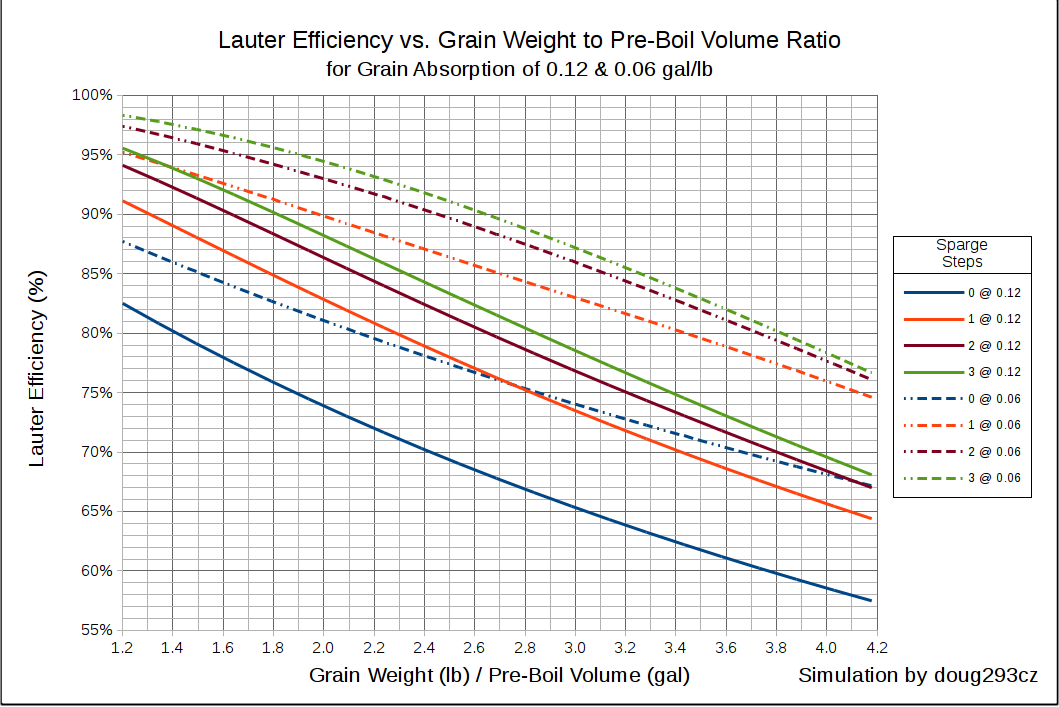ComputersCookingCats
Member
- Joined
- Jul 30, 2021
- Messages
- 7
- Reaction score
- 4
Lurked and read many threads here for a long time (such a fantastic wealth of information!) , but I finally decided to make an account because I'm stumped and need the help from the great minds in this forum.
I have an old copy of BeerSmith 2 from my forgone extract brewing days and I don't really see the need to go to BS3, so I still use BS2.
I used to just sort of wing it when it came to recipes, either using other people's recipes or just trying to get a ballpark figure of what to hit for my OG and FG. However, I decided that with moving to all-grain and getting back into homebrewing, I want to really dial in my system to get reliable numbers.
My Irish Red Ale had a pretty basic grain bill: 10lbs 2-row, 1/2 lbs caramel 40L, 1/4 lbs roasted barley (300srm), 1/4 lbs caramel 120L. When I brewed this recipe, I got numbers that were wildly off from what BS2 had estimated.
Grains were mashed in a 10-gallon cooler with 3.5 gallons at 152F, BS2 said to use 3.3 but I said screw it and used 3.5. I then did a single batch sparge with 5 gallons heated to 168, exactly like BS2 said. Their estimate was 7 gallons of pre-boil wort. I wound up with 7.75 gallons. Even assuming I was off with my BS2 equipment profile's 0.13 tun deadspace and adding in the 0.2 additional mash water, this was higher than expected.
The other thing that threw me off was that my pre-boil gravity (using hydrometer) was 1.030 rather than the estimated 1.043. This gave me a mash efficiency of 57.9% rather than the estimated 75.3% in BS2. Frustrated, I threw in 3.3 lbs of golden LME. When I boiled (90 minutes) and chilled (immersion chiller) to a 5.5 gallon batch and took my OG, it was now 1.073. When I went back to BS2 and added the extract to the recipe, I got an estimated OG of 1.075 with the estimated mash efficiency (75%) and BH efficiency (72%). This leads me to believe that my pre-boil gravity was somehow off (issue with hydrometer?) and I likely actually had a better mash efficiency than I thought.
All of this leaves me very confused. Either my LME was on steroids or else something was way off during my process of taking readings. I have a crappy brew kettle thermometer but, AFAIK, it has tested accurate when I checked against boiling water. I could probably be off a bit with my temps, but I think they're not wildly off. I'm wondering if maybe this was an issue with the grains? I did not crush my own grains; the LHB store I went to started doing it themselves during COVID and has continued with this policy. But it seems that my OG was pretty spot-on with what BS2 estimated after I added the LME.
I have an old copy of BeerSmith 2 from my forgone extract brewing days and I don't really see the need to go to BS3, so I still use BS2.
I used to just sort of wing it when it came to recipes, either using other people's recipes or just trying to get a ballpark figure of what to hit for my OG and FG. However, I decided that with moving to all-grain and getting back into homebrewing, I want to really dial in my system to get reliable numbers.
My Irish Red Ale had a pretty basic grain bill: 10lbs 2-row, 1/2 lbs caramel 40L, 1/4 lbs roasted barley (300srm), 1/4 lbs caramel 120L. When I brewed this recipe, I got numbers that were wildly off from what BS2 had estimated.
Grains were mashed in a 10-gallon cooler with 3.5 gallons at 152F, BS2 said to use 3.3 but I said screw it and used 3.5. I then did a single batch sparge with 5 gallons heated to 168, exactly like BS2 said. Their estimate was 7 gallons of pre-boil wort. I wound up with 7.75 gallons. Even assuming I was off with my BS2 equipment profile's 0.13 tun deadspace and adding in the 0.2 additional mash water, this was higher than expected.
The other thing that threw me off was that my pre-boil gravity (using hydrometer) was 1.030 rather than the estimated 1.043. This gave me a mash efficiency of 57.9% rather than the estimated 75.3% in BS2. Frustrated, I threw in 3.3 lbs of golden LME. When I boiled (90 minutes) and chilled (immersion chiller) to a 5.5 gallon batch and took my OG, it was now 1.073. When I went back to BS2 and added the extract to the recipe, I got an estimated OG of 1.075 with the estimated mash efficiency (75%) and BH efficiency (72%). This leads me to believe that my pre-boil gravity was somehow off (issue with hydrometer?) and I likely actually had a better mash efficiency than I thought.
All of this leaves me very confused. Either my LME was on steroids or else something was way off during my process of taking readings. I have a crappy brew kettle thermometer but, AFAIK, it has tested accurate when I checked against boiling water. I could probably be off a bit with my temps, but I think they're not wildly off. I'm wondering if maybe this was an issue with the grains? I did not crush my own grains; the LHB store I went to started doing it themselves during COVID and has continued with this policy. But it seems that my OG was pretty spot-on with what BS2 estimated after I added the LME.



![Craft A Brew - Safale S-04 Dry Yeast - Fermentis - English Ale Dry Yeast - For English and American Ales and Hard Apple Ciders - Ingredients for Home Brewing - Beer Making Supplies - [1 Pack]](https://m.media-amazon.com/images/I/41fVGNh6JfL._SL500_.jpg)























































